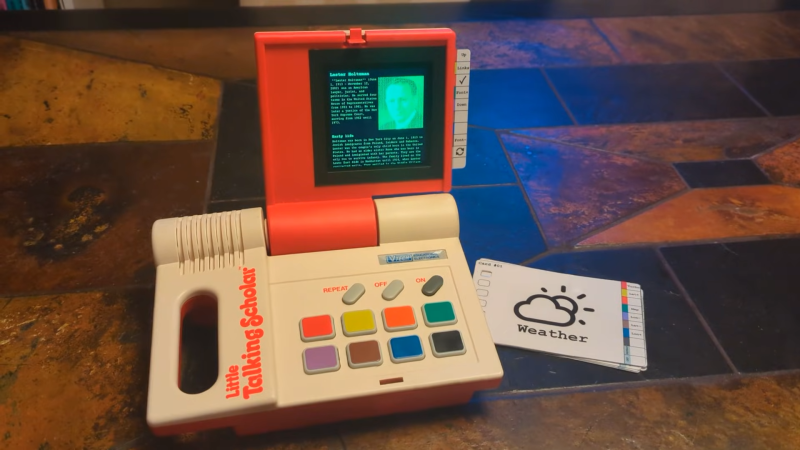
Have you ever seen a toy and said “That wants to be a deck”? [Attoparsec] did, when his eyes fell upon the Little Talking Scholar, a punch card driven toy from the 1980s. It’s now a punch card driven cyberdeck.
The punch card interface on the toy is only six bits, but sixty-four application cards are probably more than parents would have wanted to keep track of in 1989. Originally, they cued up simple matching games on an anonymous epoxy-coated microprocessor; after [Attoparsec]’s surgery, they do the same thing, cuing up custom Python applications on the Raspberry Pi Zero he’s implanted into this thing.
The square display comes courtesy of HyperPixel. It’s designed for a Pi, but both the display and the case needed a bit of surgery to get it to fit. First, a bit of milling was required on the plastic case to make room for the printed bracket to hold the display. That left depth, as the original toy had no display, which means the lid of this faux-laptop is quite thin. (The punch cards were printed with all you needed to play the games and were visible through the hole that now shows the LCD.) By removing the headers and soldering directly to the board, [Attoparsec] was able to get the display to fit, but space was then too tight for punch cards to slide in easily. Some washers added the extra space required.
A battery lives inside of the original battery compartment, but because the lithium cell he’s using is thicker than the AA’s this toy was designed for, a little bit more milling was required. A couple more holes gave a charging button and a power port.
The buttons and the punch card contacts are connected to the Pi via MCP23017 I2C port expanders, since the square display provides a handy I2C pass-through. A nice detail was putting the MCP23017s onto a custom PCB that sat directly on the contacts of the original button board. We might have used those eight buttons for a chording keyboard, but [Attoparsec] isn’t a fan of cording. Instead, the buttons are context-dependent based on the application. For text input in his note-taking application [Attoparsec] fell back on Morse, with two keys acting as paddles. We’ve seen Morse keyboards before, and while they seem like great HAM training, they can also be assistive devices.
The whole video is absolutely worth a watch, for all the details and the fun tangents [Attoparsec] goes off on. We’re grateful to [smellsofbikes] for tipping us off to this project. The tips line is always hungry for cyber decks, so let us know if you find one— or anything else interesting.
This articles is written by : Fady Askharoun Samy Askharoun
All Rights Reserved to Amznusa www.amznusa.com
Why Amznusa?
AMZNUSA is a dynamic website that focuses on three primary categories: Technology, e-commerce and cryptocurrency news. It provides users with the latest updates and insights into online retail trends and the rapidly evolving world of digital currencies, helping visitors stay informed about both markets.
